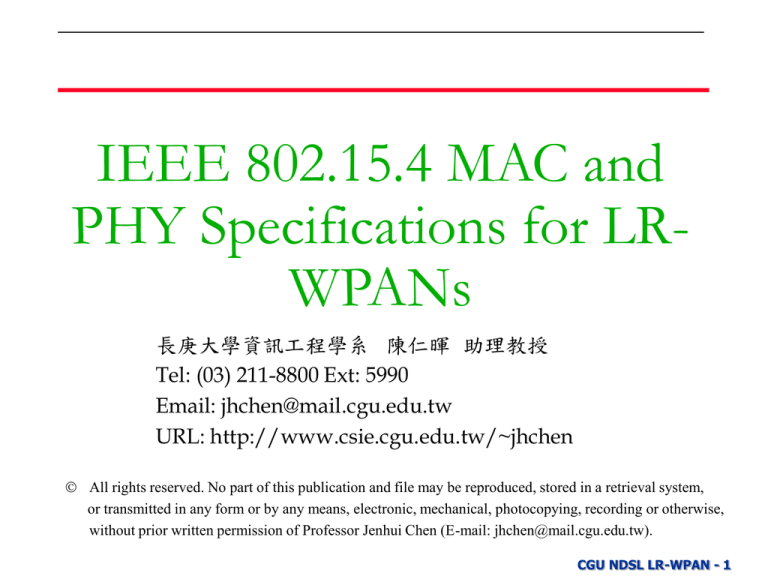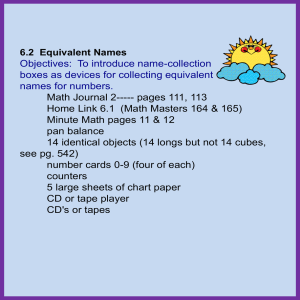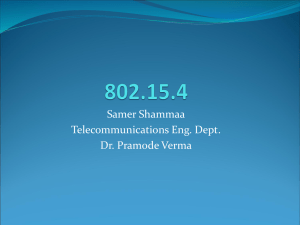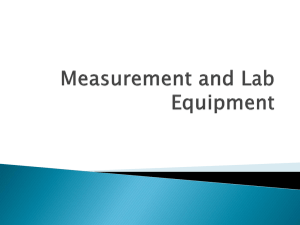
IEEE 802.15.4 MAC and
PHY Specifications for LRWPANs
長庚大學資訊工程學系 陳仁暉 助理教授
Tel: (03) 211-8800 Ext: 5990
Email: jhchen@mail.cgu.edu.tw
URL: http://www.csie.cgu.edu.tw/~jhchen
All rights reserved. No part of this publication and file may be reproduced, stored in a retrieval system,
or transmitted in any form or by any means, electronic, mechanical, photocopying, recording or otherwise,
without prior written permission of Professor Jenhui Chen (E-mail: jhchen@mail.cgu.edu.tw).
CGU NDSL LR-WPAN - 1
Outline
1. IEEE 802.15.4 Architecture and Overview
2. IEEE 802.15.4 PHY
3. IEEE 802.15.4 MAC
CGU NDSL LR-WPAN - 2
1. 802.15.4 Architecture
and Overview
CGU NDSL LR-WPAN - 3
IEEE Project 802 Standards
WLAN
WPAN
WMAN
LR-WPAN
CGU NDSL LR-WPAN - 4
IEEE 802.15 Working Group
CGU NDSL LR-WPAN - 5
Applications
•
•
•
•
•
•
•
•
Sensors & actuators
Interactive toys
Smart badges
Health monitoring
Computing peripherals
Remote control
Home Automation
Automatic Meter Reading
CGU NDSL LR-WPAN - 6
New Trend of Wireless Technology
• Most Wireless industry focus on increasing
high data throughput
• A set of applications requiring simple wireless
connectivity, relaxed throughput, very low
power, short distance and inexpensive
–
–
–
–
–
Industrial
Agricultural
Vehicular
Residential
Medical
CGU NDSL LR-WPAN - 7
Wireless Markets
HI-FI
AUDIO
STREAMING
VIDEO
>
LONG
TEXT GRAPHICS INTERNET
MULTI-CHANNEL
VIDEO
LAN
RANGE
802.11b
802.11a/HL2 & 802.11g
Bluetooth 2
<
SHORT
DIGITAL
VIDEO
ZigBee
PAN
Bluetooth1
LOW
<
DATA RATE
>
HIGH
Reference from ZigBee Alliance Inc.
CGU NDSL LR-WPAN - 8
Wireless Technologies
Range
Meters
GSM
GPRS
EDGE
3G
2000
2003-4
10,000
2005
1,000
802.11b
802.11a/g
ZigBee
100
Bluetooth 2.0
Bluetooth
10
100
WiMedia
Bluetooth 1.5
10
1,000
Hiper
LAN/2
10,000
Bandwidth
kbps
100,000
Reference from ZigBee Alliance Inc.
CGU NDSL LR-WPAN - 9
WLAN vs WPAN
CGU NDSL LR-WPAN - 10
Wireless Applications
monitors
sensors
automation
control
monitors
diagnostics
sensors
INDUSTRIAL &
COMMERCIAL
CONSUMER
ELECTRONICS
TV
VCR
DVD/CD
remote
ZigBee
PERSONAL
HEALTH CARE
consoles
portables
educational
LOW DATA-RATE
RADIO DEVICES
TOYS &
GAMES
HOME
AUTOMATION
PC &
PERIPHERALS
mouse
keyboard
joystick
security
HVAC
lighting
closures
Reference from ZigBee Alliance Inc.
CGU NDSL LR-WPAN - 11
Architecture
APPLICATION
ZIGBEE STACK
SILICON
• ZigBee Alliance
– 45+ companies: semiconductor
mfrs, IP providers, OEMs, etc.
Customer
– Defining upper layers of protocol
stack: from network to
application, including application
profiles
ZigBee
Alliance
– First profiles published mid 2003
IEEE
802.15.4
• IEEE 802.15.4 Working Group
– Defining lower layers of protocol
stack: MAC and PHY
– draft D18 (will be finalized 2003)
CGU NDSL LR-WPAN - 12
What is unique about wireless PAN (WPAN)?
• Wireless Personal Area Networks (WPANs)
–
–
–
–
–
short distance
small (ultra low complexity)
low duty-cycle (<0.1%)
power efficient (the most important factor)
inexpensive (ultra low cost) solutions.
• Typically operating in the Personal Operating
Space (POS) of 10 meters.
• Supporting star and peer-to-peer topologies
– controlled by the PAN coordinator
CGU NDSL LR-WPAN - 13
WPAN Features
• Media access is contention based.
– Using carrier sense multiple access with collision
avoidance (CSMA/CA) MAC protocol
– Similar to IEEE 802.11 CSMA/CA protocol, but not the same
• Provide the optional Superframe structure
– The PAN coordinator periodically allocates guaranteed time
slots (GTS) to low latency devices
•
Dynamic device addressing
–
Two kinds of address of a device
–
–
•
16-bit Short Address
64-bit Extended Address
Fully acknowledged protocol for transfer reliability.
CGU NDSL LR-WPAN - 14
Device Classes in WPAN
• There are two different device types :
– A full function device (FFD)
– A reduced function device (RFD)
• The FFD can operate in three modes serving
– Device
– Coordinator
– PAN coordinator
• The RFD can only operate in a mode serving:
– Device
• Coordinator provides synchronization information to
other devices
CGU NDSL LR-WPAN - 15
FFD vs RFD
• Full function device (FFD)
– Any topology
– Network coordinator capable
– Talks to any other device
• Reduced function device (RFD)
– Limited to star topology
– Cannot become a network coordinator
– Talks only to a network coordinator
– Very simple implementation
CGU NDSL LR-WPAN - 16
Network Topologies
• Star and Peer2Peer Topologies
CGU NDSL LR-WPAN - 17
Network Topologies
• Star network formation:
– An FFD may establish its own network and become the PAN
coordinator.
– All star networks operate independently.
– Choosing a PAN identifier, which is not currently used by any
other network within the radio sphere of influence.
– Both FFDs and RFDs may join the network.
• Peer-to-peer network formation:
– Each device is capable of communicating with any other
device.
– One FFD device will be nominated as the PAN coordinator.
CGU NDSL LR-WPAN - 18
Star Topology
• Home Application
FFD
RFD
FFD
PAN coordinator
RFD
RFD
RFD
FFD
CGU NDSL LR-WPAN - 19
Cluster Tree Topology
• Only one PAN coordinator
• No detail yet
Cluster Head
PAN coordinator
CGU NDSL LR-WPAN - 20
Cluster Tree Establishment
• The PAN coordinator forms the first cluster by establishing itself
as the cluster head (CLH) with a cluster identifier (CID) of zero.
• Choosing an unused PAN identifier (PANID) and broadcasting
beacon frames to neighboring devices.
• A candidate device receiving a beacon frame may request to join
the network at the CLH.
• If the PAN coordinator permits the device, it will add the new
device as a child device in its Access Control List (ACL).
• The newly joined device will add the CLH as its parent in its ACL,
and begin transmitting periodic beacons.
• Other candidate devices may then join the network at that device.
A larger network (PAN) is possible by forming a mesh of multiple
neighboring clusters.
• The PAN coordinator may instruct a device to become the CLH of
a new cluster adjacent to the first one.
• Other devices gradually connect and form a multi-cluster network
structure.
CGU NDSL LR-WPAN - 21
WPAN Addressing Methods
• Two or more devices with a POS communicating on the same
physical channel constitute a WPAN which includes at least
one FFD (PAN coordinator)
• Each independent PAN will select a unique PAN identifier
• All devices operating on a network shall have unique 64-bit
extended address. This address can be used for direct
communication in the PAN
• The address can use a 16-bit short address, which is allocated
by the PAN coordinator when the device associates
• Addressing modes:
– Network + device identifier (star)
– Source/destination identifier (peer-peer)
– Source/destination cluster tree + device identifier (cluster tree)
CGU NDSL LR-WPAN - 22
MAC/PHY Functions
• Functions in PHY sublayer
–
–
–
–
–
activation and deactivation of the radio transceiver
energy detection
link quality indication
clear channel assessment (CCA) - carrier sense
transmitting/receiving bit stream
• Functions in MAC sublayer
–
–
–
–
–
–
–
–
beacon management
channel access (slotted or unslotted CSMA/CA)
guarantee time slot management (QoS)
frame validation
acknowledged frame delivery
association
disassociation
security mechanisms (AES)
CGU NDSL LR-WPAN - 23
2. 802.15.4 Physical Layer
CGU NDSL LR-WPAN - 24
PHY Specifications
• The standard specifies two PHYs :
– 868 MHz/915 MHz direct sequence spread
spectrum (DSSS) PHY (11 channels)
» 1 channel (20Kb/s) in European 868MHz band
» 10 channels (40Kb/s) in 915 (902-928)MHz ISM band
– 2450 MHz direct sequence spread spectrum
(DSSS) PHY (16 channels)
» 16 channels (250Kb/s) in 2.4GHz band
CGU NDSL LR-WPAN - 25
PHY Specification
• PHY functionalities:
– Activation and deactivation of the radio transceiver
– Energy detection within the current channel
– Link quality indication for received packets
– Clear channel assessment for CSMA-CA
– Channel frequency selection
– Data transmission and reception
CGU NDSL LR-WPAN - 26
PHY Specification
CGU NDSL LR-WPAN - 27
Operating Frequency Range
BAND
2.4 GHz
ISM
868 MHz
915 MHz
ISM
COVERAGE
DATA RATE
CHANNEL(S)
Worldwide
250 kbps
16
Europe
20 kbps
1
Americas
40 kbps
10
• A total of 27 channels, numbered 0 to 26, are available
across the three frequency bands.
• 16 channels are for 2450 MHz, 10 are for 915 MHz an 1 is for
868 MHz.
CGU NDSL LR-WPAN - 28
PHY Parameters
• Transmit Power
– Capable of at least 1 mW
– Power reduction capability required if > 16 dBm
(reduce to < 4 dBm in single step)
• Transmit Center Frequency Tolerance
– 40 ppm
• Receiver Sensitivity
– -85dBm (2450 MHz)
– -92dBm (868/915 MHz)
– 1% Packet Error Rate in PSDU = 20 Bytes)
• RSSI Measurements
– Packet strength indication
– Clear channel assessment
– Dynamic channel selection
CGU NDSL LR-WPAN - 29
Receiver jamming resistance
• In 915MHz and 2450MHz bands
• The adjacent channel is one on either side of the
desired channel that is closest in frequency to the
desired channel, and the alternate channel is one
more removed from the adjacent channel. (in
915MHz and 2450MHz)
– For example, for channel 3, channels 2 and 4 are adjacent
channels, and channels 1 and 5 are alternative channels
CGU NDSL LR-WPAN - 30
PHY PDU Format (PPDU)
• PHY Packet Fields
– A synchronization header
» Preamble (32 bits) – 32 binary zeros used for synchronization
» Start of Packet Delimiter (8 bits) – 10100111
– A PHY header
» PHY Header (8 bits) – 7-bit frame length (0-127) and 1-bit reserved
– A payload
» PSDU (0 to 127 bytes) – Data field
4 Bytes
1 Byte
1 Byte
Preamble
Start of
Packet
Delimiter
PHY
Header
6 Bytes
PHY Service
Data Unit (PSDU)
0-127 Bytes
CGU NDSL LR-WPAN - 31
PPDU Format Length
• Frame Length Values
– aMaxPHYPacketSize : 127
– aTurnaroundTime : 12 symbol periods
CGU NDSL LR-WPAN - 32
2450 MHz PHY Specifications
• Data rate: 250 kb/s per channel
• Employing a 16-ary quasi-orthogonal modulation technique
• During each data symbol period, 4 information bits (symbol) are
used to select one of 16 nearly-orthogonal PN sequences (32
chips) to be transmitted
• The aggregate chip sequence is modulated onto the carrier
using O-QPSK (offset quadrature phase shift keying)
(b3b2b1b0)
(b7b6b5b4)
2Mchips/s
250kb/s
b7b6b5b4b3b2b1b0
2Mhz
4:1
1:32
1:1
(1 1 0 1 1 0 0 1 1 1 0 0 0 0 1 1 0 1 0 1 0 0 1 0 0 0 1 0 1 1 1 0)
62.5ksymbols/s
CGU NDSL LR-WPAN - 33
2450 MHz PHY Specifications
• Modulation Scheme
– Even chips: In-phase (I) carrier
– Odd chips: quadrature-phase (Q) carrier
– The chip rate (nominally 2.0 Mchip/s) is 32 times the symbol rate
(62.5 ksymbols/s)
– Data rate : 4 bits/symbol times 62.5 ksymbols/s = 250Kb/s
O-QPSK chip offsets
CGU NDSL LR-WPAN - 34
2450 MHz PHY Specifications
• OQPSK modulation
– Tc is the inverse of the chip rate.
Example baseband chip sequences with pulse shaping
CGU NDSL LR-WPAN - 35
868/915 MHz Band PHY Specifications
• Employing DSSS with
– binary phase shift keying (BPSK) with raised cosine pulse
shaping (rolloff factor = 1) used for chip modulation
– differential encoding used for data symbol encoding.
» Differential encoding is the modulo-2 addition of a raw data
bit (R) with the previous encoded bit (E), where E0 is 0.
» Transmitter :
» Receiver :
20kb/s
40kb/s
1:1
1:15
20ksymbols/s
40ksymbols/s
1:1
300kchips/s
600kchips/s
300khz
600khz
CGU NDSL LR-WPAN - 36
868/915 MHz Band PHY Specifications
• Symbol-to-chip mapping
• Pulse shape
– raised cosine pulse shape (rolloff factor = 1) used to represent each
baseband chip
CGU NDSL LR-WPAN - 37
General Radio Specifications
• Error vector magnitude definition:
– The modulation accuracy of a transmitter is determined with
an error-vector magnitude (EVM) measurement
: N received complex chip values
: ideal position of the chosen complex
: error vector
where S is the magnitude of the vector
to the ideal constellation point
– A compliant transmitter shall have EVM values of less than
35% when measured for 1000 chips.
CGU NDSL LR-WPAN - 38
RED and LQI
• Receiver energy detection
– The energy detection time shall be equal to 8 symbol periods
– an 8-bit integer ranging from 0x00 to 0xff
» The minimum ED value (0) shall indicate received power less
than 10 dB above the specified receiver sensitivity and the
range of received power spanned by the ED values shall be at
least 40 dB. Within this range the mapping from the received
power in dB to ED value shall be linear with an accuracy of +/6 dB.
• Link quality indication (LQI)
– may be implemented using receiver energy detection, a
signal-to-noise ratio estimation, or a combination of these.
– an 8-bit integer ranging from 0x00 to 0xff
» At least 8 unique values of LQ shall be used.
CGU NDSL LR-WPAN - 39
Clear Channel Assessment (CCA)
• Three CCA modes in IEEE 802.15.4
– CCA Mode 1: Energy above threshold. CCA shall report a
busy medium upon detecting any energy above the ED
threshold.
– CCA Mode 2: Carrier sense only. CCA shall report a busy
medium only upon the detection of a signal with the
modulation and spreading characteristics of IEEE 802.15.4.
This signal may be above or below the ED threshold.
– CCA Mode 3: Carrier sense with energy above threshold.
CCA shall report a busy medium only upon the detection of a
signal with the modulation and spreading characteristics of
IEEE 802.15.4 with energy above the ED threshold
CGU NDSL LR-WPAN - 40
3. 802.15.4 MAC Layer
CGU NDSL LR-WPAN - 41
Protocol Layer
APPLICATIONS
Customer
APPLICATION INTERFACE
SECURITY
NETWORK LAYER
Star/Cluster/Mesh
DATA LINK LAYER
MAC LAYER
MAC LAYER
PHY LAYER
2.4 GHz
915MHz
ZigBee
Alliance
IEEE
802.15.4
868 MHz
Application
ZigBee Stack
Silicon
CGU NDSL LR-WPAN - 42
IEEE 802.15.4 feature
• Extremely low cost
• Ease of installation
• Reliable data transfer
• Short range operation
• Reasonable battery life
Simple but flexible flexible protocol
CGU NDSL LR-WPAN - 43
Network Topologies
•
Star Topology
–
•
In star topology, data may be exchanged only
between the coordinator (FFD) and a device (FFD
or RFD).
Peer-Peer Topology
–
In a peer-to-peer topology,data may be exchanged
between any two devices (FFDs).
CGU NDSL LR-WPAN - 44
Star Topology
Network
coordinator
Master/slave
Full Function Device (FFD)
Reduced Function Device (RFD)
Communications Flow
CGU NDSL LR-WPAN - 45
Peer-Peer Topology
Point to point
Tree
Full Function Device (FFD)
Communications Flow
CGU NDSL LR-WPAN - 46
Combined Topology (Cluster Star)
Room 3
Room 4
Room 2
Room 1
Full Function Device (FFD)
Reduced Function Device (RFD)
Star Communications Flow
Peer2Peer Communications Flow
CGU NDSL LR-WPAN - 47
Device Addressing
• All devices have IEEE addresses (64-bits)
• Short addresses (16-bit) can be allocated
• Addressing modes:
– Network + device identifier (star)
– Source/destination identifier (peer-peer)
– Source/destination cluster tree + device identifier
(cluster tree)
CGU NDSL LR-WPAN - 48
General Frame Structure
• Four Types of Frames Structure:
– Beacon Frame - used by coordinator
– Data Frame - used for all transfers of data
– Acknowledgment Frame - used for confirming successful frame
reception
– MAC Command Frame - used for handling all MAC peer entity
control transfers
CGU NDSL LR-WPAN - 49
Superframe Structure
• The LR-WPAN allows the optional use of a superframe
structure.
• The format of the superframe is defined by the coordinator.
• The superframe is bounded by network beacons, is sent by the
coordinator and is divided into 16 equally sized slots.
• The beacon frame is transmitted in the first slot of each
superframe.
• If a coordinator does not wish to use a superframe structure it
may turn off the beacon transmissions.
• The beacons are used to synchronize the attached devices, to
identify the PAN, and to describe the structure of the
superframes.
• Any device wishing to communicate during the contention
access period (CAP) between two beacons shall compete with
other devices using a slotted CSMA-CA mechanism.
• All transactions shall be completed by the time of the next
network beacon.
CGU NDSL LR-WPAN - 50
Superframe Structure
• The superframe can have an active and an inactive portion. During
the inactive portion the PAN enters a low power mode.
• The PAN coordinator may dedicate portions of the active
superframe to some devices/applications. These portions are
called guaranteed time slots (GTSs).
• The GTSs comprise the contention free period (CFP).
• The PAN coordinator may allocate up to 7 of these GTSs and a
GTS may occupy more than one slot period. (Note:all slots may be
allocated for CFP.)
• All contention based transactions shall be complete before the
CFP begins. Also each device transmitting in a GTS shall ensure
that its transaction is complete before the time of the next GTS or
the end of the CFP.
CGU NDSL LR-WPAN - 51
Superframe Structure
• The structure of this superframe is described by the
values of macBeaconOrder (BO) and
macSuperframeOrder (SO).
– The macBeaconOrder describes the interval at which the
coordinator shall transmit its beacon frames.
– The macSuperframeOrder describes the length of the active
portion of the superframe, which includes the beacon frame.
CGU NDSL LR-WPAN - 52
Superframe Structure
• The values of BO and the beacon interval (BI) are related as
follows:
BI = aBaseSuperframeDuration 2BO symbols, if 0BO14
• The values of SO and the superframe duration (SD) are related as
follows:
SD = aBaseSuperframeDuration 2SO symbols, if 0SOBO14
• Note : If BO = 15, the coordinator will not transmit beacon and the
value of SO shall be ignored. (non beacon-enable network)
Moreover, macRxOnWhenIdle defines whether the receiver is
enabled during periods of transceiver inactivity (default : FALSE)
• If SO = 15, the superframe will not be active after the beacon.
• PANs that wish to use the superframe structure shall set
0SOBO14.
CGU NDSL LR-WPAN - 53
Superframe Structure
• The active portion of each superframe shall be
divided into aNumSuperframeSlots equally spaced
slots of duration 2SO *aBaseSlotDuration
– aNumSuperframeSlots =16 (Fixed)
– aBaseSlotDuration = 2SO 60 symbols (Variable)
– aBaseSuperframeDuration = aNumSuperframeSlots
aBaseSlotDuration = 16 2SO 60 symbols (Variable)
• The active portion is composed of three parts:
1. a beacon (with extended payload)
2. a contention access period (CAP) and
3. a contention free period (CFP).
CGU NDSL LR-WPAN - 54
Data Transfer Model
There are three types of data transfer transactions.
1) Device -> Coordinator
2) Coordinator -> Device
3) Device (coordinator) -> Device (coordinator)
CGU NDSL LR-WPAN - 55
MAC Specifications
• Superframe Structure
– Optional (named as beacon-enable network)
– The format of the superframe is define by the PAN coordinator
– Bounded by network beacons and sent by the PAN coordinator
– Divided into 16 equally sized slots and beacon is transmitted in
the first slot
– It consists of two periods
» Contention Access Period (CAP)
» Contention Free Period (CFP)
– Objects of the beacons
» synchronize
» identify the PAN
» describe the structure of the superframes
CGU NDSL LR-WPAN - 56
MAC Specifications
•
The superframe can have an active and an inactive
portion.
•
•
•
•
•
•
During the inactive portion the coordinator shall not
interact with its PAN and may enter a low power mode.
The PAN coordinator may allocate portions of the
active superframe to some applications and these
portions are called guaranteed time slots (GTSs).
The GTSs comprise the contention free period
(CFP).
The PAN coordinator may allocate up to 7 GTSs at
the same time
A GTS may occupy more than one slot period
A sufficient portion of the CAP shall remain for
contention.
CGU NDSL LR-WPAN - 57
MAC Specifications
• Any device wishing to communicate during the
CAP between two beacons shall compete with
other devices using a slotted CSMA-CA
mechanism.
• All transactions shall be completed by the time
of the next network beacon
• If the coordinator does not wish to use a
superframe structure, it can turn off the beacon
transmissions
– named as non beacon-enable network
– Using Unslotted CSMA/CA
CGU NDSL LR-WPAN - 58
Superframe Structure
CGU NDSL LR-WPAN - 59
General Frame Format
PHY Layer
MAC
Layer
Payload
Synch. Header
(SHR)
PHY Header
(PHR)
MAC Header
(MHR)
MAC Service Data Unit
(MSDU)
MAC Footer
(MFR)
MAC Protocol Data Unit (MPDU)
PHY Service Data Unit (PSDU)
• Four Types of Frames Structure:
• Beacon Frame - used by coordinator
• Data Frame - used for all transfers of data
• Acknowledgment Frame - used for confirming successful
frame reception
• MAC Command Frame - used for handling all MAC peer
entity control transfers
CGU NDSL LR-WPAN - 60
Beacon Frame Format (1/4)
CGU NDSL LR-WPAN - 61
Data Frame Format (2/4)
CGU NDSL LR-WPAN - 62
Acknowledgement Frame Format (3/4)
CGU NDSL LR-WPAN - 63
MAC Command Frame Format (4/4)
CGU NDSL LR-WPAN - 64
CSMA/CA Mechanism (1/3)
• unslotted CSMA/CA:
– A device waits for a random period without carrier
sense.
– If the channel is idle, following the random backoff,
it transmits its data. Otherwise, it waits for another
random period before retry.
• slotted CSMA/CA:
– It is similar to the unslotted CSMA/CA but follows
the backoff slot boundary.The backoff slots are
aligned with the start of the beacon transmission.
CGU NDSL LR-WPAN - 65
CSMA/CA Mechanism (2/3)
• Frame Acknowledgment
– If the originator does not receive an ACK after
some period. It will retry the frame transmission. If
an ACK is still not received after several retries,
the originator can choose either to terminate or to
try again.
• Power Consumption Considerations
– Battery powerd devices will require duty-cycling to
reduce power consumption. These devices will
spend most of their operational life in a sleep state.
They shall periodically listen to the RF channel to
determine whether a message is pending.
CGU NDSL LR-WPAN - 66
Security (1/2)
• Security implementation in the MAC sublayer
– maintain an access control list (ACL)
– use symmetric cryptography to protect transmitted frames.
– The higher layers determine when security is to be used at
the MAC sublayer, provide all keying material, Key
management, device authentication and freshness
protection.
• Security modes
– Unsecured mode
– ACL mode
– Secured mode
»
»
»
»
Access control (protect STA from being attacked, needs ACL)
Data encryption (protect data from being resolved)
Frame integrity (protect data from being modified)
Sequential freshness (protect data from being replayed)
CGU NDSL LR-WPAN - 67
Data Transmissions
(1) Data transferred from device to coordinator
– In a beacon-enable network, device finds the beacon to
synchronize to the superframe structure. Then using
slotted CSMA/CA to transmit its data.
– In a non beacon-enable network, device simply transmits
its data using unslotted CSMA/CA
Communication to a coordinator
In a beacon-enabled network
Communication to a coordinator
In a non beacon-enabled network
CGU NDSL LR-WPAN - 68
Data Transmissions
(2) Data transferred from coordinator to device
– In a beacon-enable network, the coordinator indicates in
the beacon that the data is pending. Device periodically
listens to the beacon and transmits a MAC command
request using slotted CSMA/CA if necessary.
– In a non beacon-enable network, a device transmits a
MAC command request using unslotted CSMA/CA. If the
coordinator has its pending data, the coordinator transmits
data frame using unslotted CSMA/CA. Otherwise,
coordinator transmits a data frame with zero length
payload.
CGU NDSL LR-WPAN - 69
Data Transmissions (Indirect mode)
• indirect transmission
pending list
Communication from a coordinator
in a non beacon-enabled network
Communication from a coordinator
In a beacon-enabled network
CGU NDSL LR-WPAN - 70
Indirect transmissions
• Since the standard favors very low cost devices that,
in general, will be battery powered, transactions can
be instigated from the devices themselves rather than
from the coordinator.
– either coordinator indicates in its beacon when messages
are pending for devices
– or devices polls the coordinator to determine if they have any
messages pending.
– Such transfers are called indirect transmissions.
• For each transaction sent, if another exists for the
same device, the coordinator sets its frame pending
subfield to 1, indicating the additional pending data.
– Like ‘more data’ flag used in IEEE 802.11
CGU NDSL LR-WPAN - 71
Pending Address Field
maximal 7 addresses
Beacon Frame
CGU NDSL LR-WPAN - 72
Message sequence chart
macAckWaitDuration
macAckWaitDuration
CGU NDSL LR-WPAN - 73
Extracting pending data
• The transmits beacons include the pending address lists
– The maximal number of addresses in pending list is 7.
• If the coordinator has enough time to determine whether the
device has a frame pending and is still able to send the ACK
frame within macAckWaitDuration symbols,
– it sets the actual frame pending subfield of the ACK frame.
– Otherwise, the coordinator set the frame pending subfield of the
ACK frame to 1 (i.e., announce first)
» If there is no pending data, coordinator will send a data frame
containing 0 length payload to device, and without requesting ACK
» Drawback : waste device’s power
• macAckWaitDuration is set as
– 120 symbols, if 0 channel 10 (868/915MHz)
– 54 symbols, if 11 channel 26 (2.4GHz)
CGU NDSL LR-WPAN - 74
Data Service
Recipient
MAC
Originator
MAC
MCPS-DATA.request
Originator
Recipient
Channel
access
Data frame
Acknowledgement
(if requested)
MCPS-DATA.indication
MCPS-DATA.confirm
CGU NDSL LR-WPAN - 75
Peer-to-Peer Data Transfers
• In order to do this effectively, the devices wishing to
communicate will either need to be receiving
constantly or they will need to synchronize with each
other.
• In the former case, the device can simply transmit its
data using unslotted CSMA-CA. In the latter case,
other measures need to be taken in order to achieve
synchronization.
CGU NDSL LR-WPAN - 76
Contention access period (CAP)
• The CAP shall be at least aMinCAPLength (=440)
symbols, unless additional space is needed to
temporarily accommodate
– the beacon frame length needed to perform GTS
maintenance
– the size of the CFP
• MAC command frames shall always be transmitted in
the CAP
CGU NDSL LR-WPAN - 77
Frame Types
CGU NDSL LR-WPAN - 78
MAC command frames
CGU NDSL LR-WPAN - 79
Inter-frame spacing
• The MAC sublayer needs a finite amount of time to
process data received by the PHY layer.
– Needs inter-frame spacing (IFS) period.
• The length of the IFS period is dependent on the size
of the frame that has just been transmitted.
– Frames (MPDUs) of up to aMaxSIFSFrameSize (=18 octets)
shall be followed by a short inter-frame spacing (SIFS) period
» The SIFS duration aMinSIFSPeriod (=12) symbols
– Frames (MPDUs) with lengths greater than
aMaxSIFSFrameSize shall be followed by a long inter-frame
spacing (LIFS)
» The LIFS duration aMinLIFSPeriod (=40) symbols
CGU NDSL LR-WPAN - 80
Inter-frame spacing
CGU NDSL LR-WPAN - 81
CSMA-CA Algorithm
•
The LR-WPAN uses two types of channel access
mechanism, depending on the network
configuration.
1. Non beacon-enabled networks use an unslotted CSMA-CA
channel access mechanism.
2. Beacon-enabled networks use a slotted CSMA-CA channel
access mechanism.
In both cases, the algorithm is implemented using units of time
called backoff periods, where one backoff period shall be equal
to aUnitBackoffPeriod (=20) symbols.
CGU NDSL LR-WPAN - 82
CSMA-CA Algorithm
• In slotted CSMA-CA, the backoff period boundaries shall be
aligned with the superframe slot boundaries
– the start of the first backoff period of each device is aligned with the
start of the beacon transmission.
• In unslotted CSMA-CA, the backoff periods of one device are
not related in time to the backoff periods of any other device in
the PAN.
• The CSMA-CA algorithm shall not be used for the transmission
of
– beacon frames
– acknowledgement frames
– data frames transmitted in the CFP.
CGU NDSL LR-WPAN - 83
CSMA-CA Algorithm
• Each device shall maintain three variables for each transmission
attempt:
– NB (no. of backoff – also known as retry count) (4)
– CW (contention window size, perform PHY CCA)
– BE (backoff exponent)
• NB is the number of times the CSMA-CA algorithm was required
to backoff while attempting the current transmission; this value
shall be initialized to 0 before each new transmission attempt.
• CW is the contention window length, defining the number of
backoff periods that need to be clear of channel activity before
the transmission can commence; this value shall be initialized to
2 before each transmission attempt. The CW variable is only
used for slotted CSMA-CA.
• BE is the backoff exponent which is related to how many backoff
periods a device shall wait before attempting to assess a
channel.
CGU NDSL LR-WPAN - 84
CSMA-CA Algorithm
• macBattLifeExt flag : This indicates whether battery life
extension, by reduction of coordinator receiver operation time
during the CAP, is enabled. (default : FALSE)
– macBattLifeExtPeriods : the number of backoff periods during
which the receiver is enabled following a beacon in battery life
extension mode. (active shorter and sleep more)
» This value is dependent on the currently selected logical channel
» For phyCurrentChannel (0-10), this value is equal to 8.
» For phyCurrentChannel (11-26), this value is equal to 6.
• macMinBE value : The minimum value of the backoff exponent
in the CSMA-CA algorithm.
– If this value is set to 0, collision avoidance is disabled during the
first iteration of the algorithm.
– Values :0-3 (default : 3)
• aMaxBE value : The maximum value of the backoff exponent in
the CSMA-CA algorithm.
– Value = 5 (that is, max 32 backoff slots)
CGU NDSL LR-WPAN - 85
The CSMA-CA algorithm
• In unslotted systems, or slotted systems with
macBattLifeExt set to FALSE,
– BE = macMinBE (=3 default)
• In slotted systems with macBattLifeExt set to TRUE, this
value shall be initialized to
– BE = min(2, macMinBE)
• For each transmission, the MAC delay for a random number of
backoff periods in the range [0,2BE-1]
• If the number of backoff periods is greater than the remaining
number of backoff periods in the CAP, the MAC shall pause the
backoff countdown at the end of the CAP and resume it at the
start of the CAP in the next superframe.
• As backoff time is up, the PHY perform a clear channel
assessment (CCA) twice since CW=2
CGU NDSL LR-WPAN - 86
Flow Chart
CGU NDSL LR-WPAN - 87
Channel Scan
• Four channel scans
–
–
–
–
Active scan
Passive scan
Orphan scan
Energy detection scan
• All devices shall be capable of performing passive
and orphan scans across a specified list of channels.
• An FFD shall be able to perform energy detection and
active scans.
CGU NDSL LR-WPAN - 88
Energy detection channel scan
• FFD obtain the peak energy in each requested
channel.
• A PAN coordinator select a channel for a new PAN.
• During an energy detection scan, the MAC sublayer
shall discard all frames received over the PHY layer
data service.
CGU NDSL LR-WPAN - 89
Active channel scan
• An active scan allows an FFD to locate any existing
coordinator transmitting beacon frames within its POS
• This is used by PAN coordinator to select a PAN
identifier prior to starting a new PAN, or it could be
used by a device prior to association.
CGU NDSL LR-WPAN - 90
Passive channel scan
• A passive scan, like an active scan, allows a device
to locate any coordinator transmitting beacon frames
within its POS.
• The beacon request command, however, is not
transmitted. This type of scan could be used by a
device prior to association.
CGU NDSL LR-WPAN - 91
Orphan channel scan
• Allows a device to attempt to relocate its coordinator following a
loss of synchronization.
• If a coordinator receives the orphan notification command
– it searches its device list for the device sending the command.
– If found, it sends a coordinator realignment command to the
orphaned device.
– The coordinator realignment command contains
»
»
»
»
its current PAN identifier
macPANId
its current logical channel
the short address of the orphaned device
• The coordinator realignment command shall occur within
aResponseWaitTime symbols.
• The orphan scan shall terminate when
– receives a coordinator realignment command
– the specified set of logical channels has been scanned.
CGU NDSL LR-WPAN - 92
MAC Command Frame Formats
goto MAC command frame format
CGU NDSL LR-WPAN - 93
Orphaned device realignment
• If the next higher layer receives repeated
communications failures following its requests to
transmit data, it concludes that it has been
orphaned.
• If the orphan scan is successful, the device
updates its MAC PIB (PAN Information Base) with
the PAN information contained in the coordinator
realignment command.
• If the orphan scan was unsuccessful, the next
higher layer shall decide what further action need
be taken, e.g. to retry the orphan scan or attempt
to re-associate.
CGU NDSL LR-WPAN - 94
PAN identifier conflict resolution
• When two PANs exist in the same POS with the same PAN
identifier.
– The coordinator and its devices performs PAN identifier conflict
resolution procedure.
• PAN coordinator detects conflict :
– Beacon frame is received by the PAN coordinator with the PAN
coordinator subfield set to 1 and the PAN identifier equal to
macPANId.
– A PAN ID conflict notification command is received by the PAN
coordinator from a device on its PAN.
• Device detects conflict :
– Beacon frame is received by the device with the PAN coordinator
subfield set to 1, the PAN identifier equal to macPANId and an
address which is not equal to both macCoordShortAddress and
macCoordExtendedAddress.
CGU NDSL LR-WPAN - 95
PAN identifier conflict resolution
• PAN coordinator detects conflict:
– Action
» first perform an active scan
» using the information from the scan, select a new PAN identifier
» broadcast the coordinator realignment command containing the
new PAN identifier with the source PAN identifier field equal to the
value in macPANId
• Device detects conflict :
– Action
» it generates the PAN ID conflict notification command and send it
to the PAN coordinator.
» If the PAN coordinator receives it correctly, it sends an
acknowledgment frame to confirm receipt.
» The PAN coordinator then resolve the conflict as described above.
CGU NDSL LR-WPAN - 96
Starting a PAN
• A PAN is started by
– an FFD
– after an active channel scan
– a suitable PAN identifier is selected
• The algorithm for selecting a suitable PAN
identifier from the list of PAN descriptors returned
from the active channel scan procedure is out of
the scope of this standard.
• The FFD sets macShortAddress to a value less
than 0xffff.
CGU NDSL LR-WPAN - 97
Beacon generation
• A device transmits beacon frames only if macShortAddress
0xffff.
• The FFD may either begin beacon transmission as the PAN
coordinator of a new PAN or as a device on a previously
established PAN.
• The address used in the source address field of the beacon
frame shall contain
– aExtendedAddress when macShortAddress = 0xfffe
– macShortAddress otherwise.
• All beacon frames shall be transmitted at the beginning of each
superframe at an interval equal to aBaseSuperframeDuration *
2n symbols, where n is the value of macBeaconOrder.
CGU NDSL LR-WPAN - 98
Device discovery
• An FFD may indicate its presence on a PAN to
other devices by transmitting beacon frames.
This allows the other devices to perform device
discovery.
CGU NDSL LR-WPAN - 99
Association
• A device first performs active or passive channel scan
• Then choose a suitable PAN
• Sent an associate request command frame to the PAN
coordinator and waits the returned acknowledgement frame
– The ack frame does not mean that the device has associated
– The coordinator decides within aResponseWaitTime symbols
• Receive an association response command frame with
status code from coordinator
– Success : contains a short address to the device
– Failure : sufficient resources are not available
• Following the selection of a PAN, it sets
– phyCurrentChannel
– macPANId
– macCoordExtendedAddress
or macCoordShortAddress,
associate request command frame
CGU NDSL LR-WPAN - 100
Association Request Command Format
FFD/RFD
CGU NDSL LR-WPAN - 101
Association
• If the association is successful, the device shall
store the addresses of the coordinator with which
it has associated.
– the short address of the coordinator (contained in the
beacon) is stored in macCoordShortAddress
– the extended address of the coordinator (contained in
the MAC header of the association response command
frame) is stored in macCoordExtendedAddress.
CGU NDSL LR-WPAN - 102
Association
• The device also stores the assigned short address
into macShortAddress
• Three types of macShortAddress
– 0x0000-0xfffd : for data communications
– 0xfffe : still uses 64-bit extended address even associated
– 0xffff : not associated yet
CGU NDSL LR-WPAN - 103
Disassociation
• When a coordinator wants one of its associated
devices to leave the PAN, it shall send the
disassociation notification command frame to the
device using indirect transmission.
disassociation notification command frame
CGU NDSL LR-WPAN - 104
Frame Transmission
• If the source address (SA) field is not present, the
originator of the frame shall be assumed to be the PAN
coordinator.
• If the destination address (DA) field is not present, the
recipient of the frame shall be assumed to be the PAN
coordinator.
• If both SA and DA addresses are present, the MAC shall
compare the destination and source PAN identifiers
– If the PAN identifiers are identical, the intra PAN subfield of the
frame control field shall be set to 1 and the source PAN
identifier shall be omitted from the transmitted frame.
» Save bandwidth, only carry the destination PAN identifier
– If the PAN identifiers are different, the intra PAN subfield of the
frame control field shall be set to 0 and both destination and
source PAN identifier fields shall be included in the
transmitted frame.
CGU NDSL LR-WPAN - 105
Frame reception and rejection
1. The frame type subfield shall not contain an illegal frame type.
2. If the frame type indicates that the frame is a beacon frame,
the source PAN identifier shall match macPANId unless
macPANId is equal to 0xffff, in which case the beacon frame
shall be accepted regardless of the source PAN identifier.
3. If a destination PAN identifier is included in the frame, it shall
match macPANId or shall be the broadcast PAN identifier
(0xffff).
4. If a short DA is included in the frame, it shall match either
macShortAddress or the broadcast address (0xffff). Otherwise,
it shall match aExtendedAddress.
5. If only SA fields are included in a data or MAC command
frame, the frame shall only be accepted if the device is a PAN
coordinator and the source PAN identifier matches macPANId.
CGU NDSL LR-WPAN - 106
Acknowledgment Request Mechanism
• Acknowledgement request (AR) subfield set to 0
– Beacon frame
– Acknowledgment frame
– Any broadcast frame
• The transmission of an acknowledgement frame in
the CAP shall commence at a backoff slot boundary.
CGU NDSL LR-WPAN - 107
Retransmissions
• If direct transmission
fails, the device
retransmits the frame
and waiting for the ACK,
up to a maximum of
aMaxFrameRetries
times.
success
fail after retry
success after retry
CGU NDSL LR-WPAN - 108
GTS allocation and management
• Guaranteed time slot (GTS) allows a device to
operate on the channel without interferences.
• A GTS only be allocated by the PAN coordinator and
is used for communications between PAN coordinator
and device.
• A data frame transmitted in an allocated GTS shall
use only short address
• The PAN coordinator shall send all frames within a
receive GTS with AR=1
• The PAN coordinator may allocate up to seven GTSs
at the same time, provided there is sufficient capacity
in the superframe.
CGU NDSL LR-WPAN - 109
GTS allocation and management
• A single GTS occupies one or more superframe slots
• GTSs are allocated on a first-come-first-served basis and all
GTSs shall be placed contiguously at the end of the superframe
and after the CAP
• For each GTS, the PAN coordinator records
–
–
–
–
starting slot
length (in superframe slots)
direction
associated device address
• For each allocated GTS, the device records
– starting slot
– length
– direction
CGU NDSL LR-WPAN - 110
GTS Allocation
initiated by a device
Inform the GTS
CGU NDSL LR-WPAN - 111
GTS request command frame
GTS request command frame
0: receive
0: GTS allocation
1: transmit
1: GTS deallocation
(device’s view)
CGU NDSL LR-WPAN - 112
GTS Deallocation
initiated by a device
initiated by coordinator
CGU NDSL LR-WPAN - 113
GTS reallocation
deallocated
compact
CGU NDSL LR-WPAN - 114
GTS expiration
• The PAN coordinator attempts to detect when a
device has stopped using a GTS using the
following rules:
– For a transmit GTS (uplink), the PAN coordinator does
not receive data frames from the device at least every
2*n superframes
– For receive GTSs (downlink), the PAN coordinator does
not receive ACK frames from the device at least every
2*n superframes
• The value of n is defined as follows:
– n = 2(8-macBeaconOrder)
–n=1
0 ≤ macBeaconOrder ≤ 8
9 ≤ macBeaconOrder ≤ 14
CGU NDSL LR-WPAN - 115
General MAC frame format
frame control field
CGU NDSL LR-WPAN - 116
Frame control field
• Frame type
–
–
–
–
Beacon (000)
Data (001)
Acknowledgment (010)
MAC command (011)
• Security enabled subfield (like WEP bit in 802.11)
– Encrypted (1)
– No Encryption (0)
• Frame pending subfield (like More bit in 802.11)
– Device sending the frame has additional data to send (1)
– No more data (0)
– Used in CAP only
• Acknowledgment request subfield
– Need ACK (1)
– Bypass ACK(0)
CGU NDSL LR-WPAN - 117
Frame control field
• Intra PAN subfield
– both DA and SA are present and the frame should not contain the
source PAN identifier field (1)
– both DA and SA are present and the frame shall contain both
destination and source PAN identifier fields (0)
• Destination addressing mode subfield
• Source addressing mode subfield
CGU NDSL LR-WPAN - 118
Sequence number field
• The sequence number field is 8-bits in length
• In the case of a beacon frame, the sequence
number field shall specify a beacon sequence
number (BSN).
– Each coordinator shall store its current BSN value in the
MAC PIB attribute macBSN and initialize it to a random
value.
• In the case of a data, acknowledgment or MAC
command frame, the sequence number field shall
specify a data sequence number (DSN) that is
used to match an acknowledgment frame to the
data or MAC command frame.
CGU NDSL LR-WPAN - 119
PAN identifier field
• 16-bits in length
• Destination PAN ID
– A value of 0xffff in this field shall represent the
broadcast PAN identifier which shall be accepted as a
valid PAN identifier by all devices currently listening to
the channel.
• Source PAN ID
– Appear in the MAC frame only if
» source addressing mode = 1
» intra PAN subfields = 0
CGU NDSL LR-WPAN - 120
Address fields
• Either 16- or 64-bits in length, according to the
value specified in the source/destination
addressing mode subfield of the frame control
field.
CGU NDSL LR-WPAN - 121
CRC-16
CGU NDSL LR-WPAN - 122
Format of individual frame types
• There are four defined frame types:
–
–
–
–
Beacon
Data
Acknowledgment
MAC command.
CGU NDSL LR-WPAN - 123
Beacon frame format
Beacon frame
BO
SO
specifies the final
superframe slot in CAP
CGU NDSL LR-WPAN - 124
Superframe specification field
• The battery life extension subfield indicates frames
transmitted to the beaconing device during the CAP
are required to start in or before the sixth full backoff
period following the beacon’s IFS period. Otherwise,
the battery life extension subfield shall be set to 0.
CGU NDSL LR-WPAN - 125
Beacon frame format
=0
>0
always appear
the direction of data frame
transmission by the device
GTS descriptor
CGU NDSL LR-WPAN - 126
Pending address information fields
Beacon frame
3-bit
3-bit
CGU NDSL LR-WPAN - 127
Address list field
• The size of the address list field is determined by
the values specified in the pending address
specification field of the beacon frame.
• The address list shall not contain the broadcast
short address 0xffff.
• The maximum number of addresses pending shall
be limited to seven and may be comprised of both
short and extended addresses.
• All pending short addresses appear first in the list
followed by any extended addresses
CGU NDSL LR-WPAN - 128
Data frame format
• The address length is depending on following parameters
defined in frame control field
– Destination addressing mode subfield
– Source addressing mode subfield
• The sequence number is the data sequence number (DSN)
variable
(DSN)
CGU NDSL LR-WPAN - 129
Acknowledgment frame format
• The frame pending subfield in frame control field
shall be set according to whether the device
sending the ACK frame has more data pending for
the recipient.
CGU NDSL LR-WPAN - 130
MAC command frame format
variable
CGU NDSL LR-WPAN - 131
Association request command
• The source addressing mode subfield of the frame
control field shall be set to 3 (64-bit extended
addressing).
• The destination addressing mode subfield shall be
set to the same mode as indicated in the beacon
frame.
• The destination address field shall contain the
coordinator’s address from the beacon frame.
• The source PAN identifier field shall contain the
broadcast PAN identifier (0xffff). The source address
field shall contain the value of aExtendedAddress.
CGU NDSL LR-WPAN - 132
Association request command
3+14 or 3+20
CGU NDSL LR-WPAN - 133
Capability information field
• Alternate PAN coordinator subfield
– the device can act as a PAN coordinator (1)
– Otherwise (0)
• Device type subfield
– the device is an FFD (1)
– the device is a RFD (0)
• power source subfield
– the device is receiving power from the alternating
current mains (1)
– Otherwise (0)
• receiver on when idle subfield
– device does not disable its receiver to conserve power
during idle periods (1)
– Otherwise (0)
CGU NDSL LR-WPAN - 134
Capability information field
• Security capability subfield
– the device is capable of sending and receiving MAC
frames secured using the security suite (1)
– Otherwise (0)
• Allocate Address subfield
– the device request a short address (1)
– Otherwise; the special short address of 0xfffe shall be
allocated to the device and returned through the association
response command (0)
CGU NDSL LR-WPAN - 135
Association response command
3+20
• Short address filed
– 0xffff : the coordinator was not able to associate this device
to its PAN (the association status field contains the reason
for the failure)
– 0xfffe : the device has been successfully associated with a
PAN but has not been allocated a short address
– 0x0000-0xfffd : the device has been successfully associated
with a PAN and has been allocated a short address.
CGU NDSL LR-WPAN - 136
Association status field
CGU NDSL LR-WPAN - 137
Disassociation notification command
3+14
• Either the coordinator or an associated device
may send the disassociate notification command.
• DA = aExtendedAddress (Coordevice) or
DA = macCoordExtendedAddress (deviceCoor)
• SA = aExtendedAddress.
CGU NDSL LR-WPAN - 138
Disassociation reason field
CGU NDSL LR-WPAN - 139
Data request command
• All devices shall be capable of transmitting this
command, although an RFD is not required to be
capable of receiving it.
CGU NDSL LR-WPAN - 140
PAN ID conflict notification command
• The PAN ID conflict notification command is sent by a
device to the PAN coordinator when a PAN identifier
conflict is detected.
CGU NDSL LR-WPAN - 141
Orphan notification command
• The orphan notification command is used by an
associated device that has lost synchronization with
its coordinator.
CGU NDSL LR-WPAN - 142
Beacon request command
• The beacon request command is used by a
device to locate all coordinators within its POS
during an active scan.
• This command is optional for an RFD.
CGU NDSL LR-WPAN - 143
Coordinator realignment command
• The coordinator realignment command is sent by a
coordinator :
– following the reception of an orphan notification command
from a device that is recognized to be on its PAN
– when any of its PAN configuration attributes change.
• If the coordinator realignment command is broadcast
to the PAN, the short address field shall be set to
0xffff and ignored on reception.
CGU NDSL LR-WPAN - 144
GTS allocation and deallocation
GTS request command format
1 : allocation
0: deallocation
• An associated device uses this command to
request the allocation of a new GTS or the
deallocation of an existing GTS.
CGU NDSL LR-WPAN - 145
MAC Constants (1/2)
CGU NDSL LR-WPAN - 146
MAC Constants (2/2)
CGU NDSL LR-WPAN - 147
MAC PIB
Attributes
CGU NDSL LR-WPAN - 148
MAC PIB Attributes (1/3)
CGU NDSL LR-WPAN - 149
MAC PIB Attributes (2/3)
CGU NDSL LR-WPAN - 150
MAC PIB Attributes (3/3)
CGU NDSL LR-WPAN - 151
MAC PIB security attributes
CGU NDSL LR-WPAN - 152
Elements of ACL entry descriptor
CGU NDSL LR-WPAN - 153
PAN start message sequence chart - PAN
coordinator
CGU NDSL LR-WPAN - 154
Energy
detection
scan
CGU NDSL LR-WPAN - 155
Association
message
sequence
chart device
CGU NDSL LR-WPAN - 156
Passive
scan
message
sequence
chart
CGU NDSL LR-WPAN - 157
Data
transmission
message
sequence
chart originator
CGU NDSL LR-WPAN - 158
Data
transmission
message
sequence
chart recipient
CGU NDSL LR-WPAN - 159
More Information
www.IEEE802.org
– http://www.ieee802.org/15/pub/TG4.html
Thank You.
Questions ?
CGU NDSL LR-WPAN - 160
CGU NDSL LR-WPAN - 161









